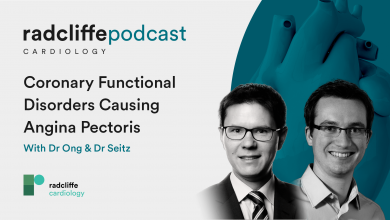Search results
Author(s):
Kevin Cheng
,
Paul Sainsbury
,
Michael Fisher
,
et al
Added:
3 years ago
Refractory angina (RA) is conventionally defined as a chronic condition (≥3 months in duration) characterised by angina in the setting of coronary artery disease (CAD), which cannot be controlled by a combination of optimal medical therapy, angioplasty or bypass surgery, and where reversible myocardial ischaemia has been clinically established to be the cause of the symptoms.1
In clinical…
View more
Author(s):
Peter Ong
,
Andreas Seitz
Added:
2 years ago
Did you know that coronary vasomotion disorders are a frequent cause of angina in patients with non-obstructed coronary arteries?
In this month's episode of the ECR podcast, Dr Andreas Seitz and Dr Peter Ong (Robert-Bosch Hospital, Stuttgart, DE) return to discuss their recent article on the diagnosis of coronary disorders which cause anginafrom ECR Journal. Over the course of this recording, Dr…
View more
Author(s):
Sascha Beck
,
Valeria Martínez Pereyra
,
Andreas Seitz
,
et al
Added:
2 years ago
Author(s):
Kevin Cheng
,
Ranil de Silva
Added:
3 years ago
Refractory angina (RA) is defined as chronic angina-type chest pain (duration ≥ 3 months) associated with reversible ischaemia that persists despite optimal medical, interventional and surgical management.1
The clinical burden of RA is growing due to an ageing population and improved survival from coronary artery disease (CAD). Estimates suggest that in the US between 600,000 and 1.8 million…
View more
Ep 5: Invasive Diagnosis of Coronary Functional Disorder
Author(s):
Peter Ong
,
Andreas Seitz
Added:
2 years ago
Podcast Episode
Author(s):
Jason M Tarkin
,
Juan Carlos Kaski
Added:
3 years ago
Stable angina pectoris is the most prevalent clinical manifestation of coronary heart disease. While the overall prognosis in patients with stable angina is good, with a low yearly event rate of ~1–2 %,1 for many, adequate symptom control can be difficult to achieve, leading to significantly impaired quality of life.
The traditional approach to the pharmacological management of stable angina, as…
View more
Author(s):
Marie Mide Michelsen
,
Naja Dam Mygind
,
Daria Frestad
,
et al
Added:
3 years ago
Women have for many years been regarded as being at relatively low risk for the development of ischaemic heart disease (IHD).1,2 Recently this pattern has changed and cardiovascular disease (CVD) is now the leading cause of death for women in Europe.3,4 Under the age of 60 years acute coronary syndrome occurs 3–4 times more often in men; however, after the age of 75 years women represent the…
View more
Author(s):
Philip A Poole-Wilson
Added:
3 years ago
Angina pectoris is a symptom that is usually, in the developed world, caused by obstruction to the coronary arteries by the enlargement of atheromatous lesions; there are other causes. The symptom can limit lifestyle, but more importantly is a repetitive reminder to the patient of the presence of heart disease, causing continual anxiety because of the belief that angina is the portent of early…
View more
Author(s):
John F Beltrame
,
Peter Ong
,
Filippo Crea
Added:
7 months ago
Stable Angina Medical Therapy
Author(s):
Talla A Rousan
,
Udho Thadani
Added:
3 years ago
Article

















